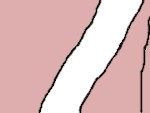|
If my body is a text, whether metaphorically or literally, it is a narrative, a narrative of passing. Before I dropped out of high school, I didn’t know what I was cloaking when I donned the discursive conventions of passing, when I borrowed my science teacher’s smile and when I adopted my cousin’s pronunciation of cauliflower. I hadn’t yet been given the scarlet A from a neuropsychologist. I hadn’t yet known that my stims were stims, that my tics were tics, that my perseverations were anything other than me or awesome.
Tim Page (2007), in “Parallel Play,” recounted the relief he felt upon his receipt of the Asperger’s label. He maintained that his life—or the texts that comprise his body and his life—rotated between bouts of passing and not passing, between bouts of visibility and invisibility. Upon becoming more cognizant of his scarlet A, Page began to likewise reflect on the ways in which he borrows facial expressions—or discourse conventions, I forget which—emulating the winks and walks of others, trying on body movements as though they were pants at Sears. In this sense, and painfully so, Page and I have become uber-aware of our position as socially constructed human beings, of our position as jointly authored narratives, texts ready for shaping, editing, and reprimand. And, while every person is jointly authored and constructed in the sense that their parents insist they don’t pick their noses or tell Nancy that she’s fat—it seems to me, and G. Thomas Couser (2008), that the role of collaborative authorship within narratives of disability plays a much more normative, egregious role. What’s at stake here isn’t propriety or boogers: what’s at stake are the ways in which we, as humans and compositionists, label or diagnose ourselves and others, the ways in which we create arbitrary normalities and arbitrary deviants, the ways in which those hunkering at the edges of the bell curve flounder into isolation and freakishness.
|















